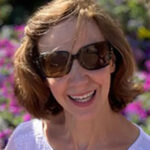Long view into time
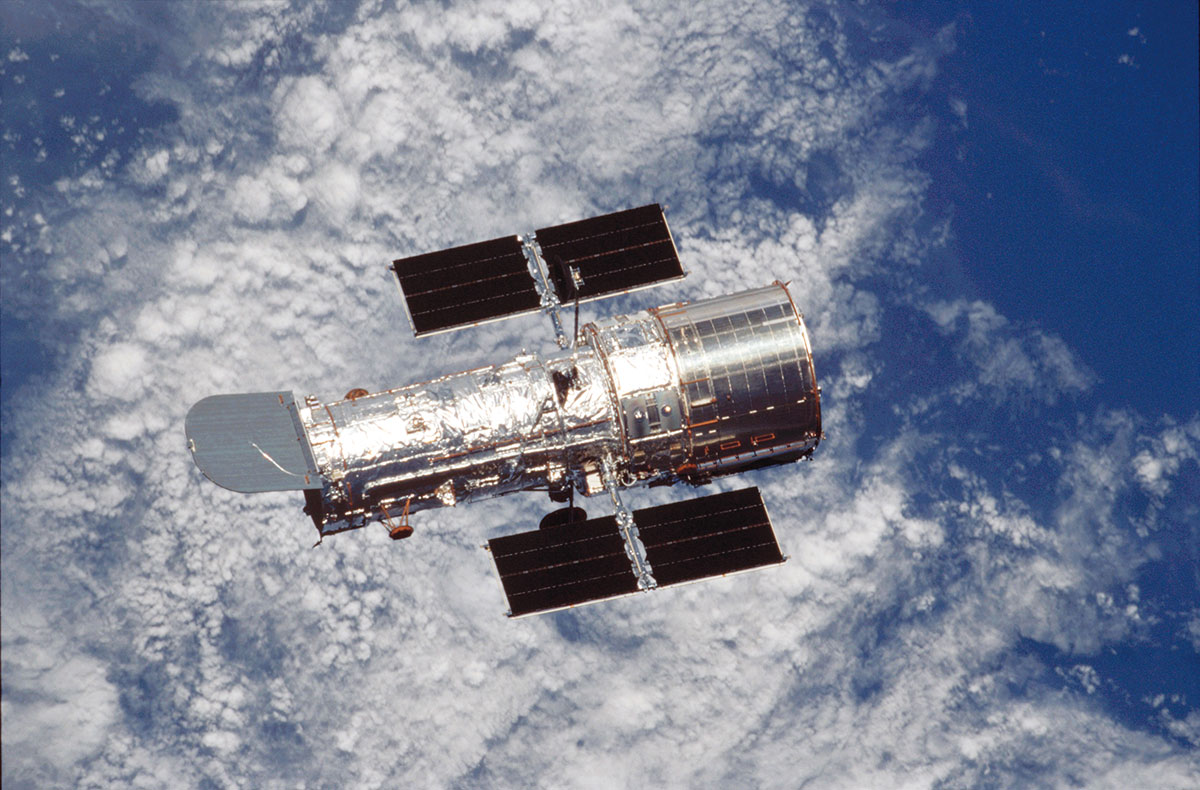
Following five service days on the Hubble Space Telescope in March 2002, the STS-109 crew photographs the observatory as it returns to low-Earth orbit. Replaced in this service mission were the solar array panels, the power control unit and the Faint Object Camera. NASA
Repair missions from Kennedy Space Center extend the life of the Hubble Telescope
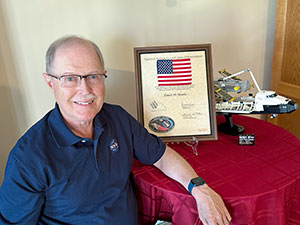
Former NASA payload manager Bob Webster teaches a course on the Hubble Space Telescope at Duke University near his home in North Carolina. BOB WEBSTER
The Hubble Space Telescope 340 miles in orbit above the Earth has mesmerized stargazers with images of the universe’s beauty and mysteries for decades and is still going strong.
The first observatory designed to be serviced in space, it is considered to be the most productive scientific instrument ever built. Hubble’s saga is as much one of high drama as it is scientific discovery. Its story arcs with tragedy, heroes and ultimate victory over the years after its launch and five service trips — all launched from the Kennedy Space Center.
Challenges started well before space shuttle Discovery roared into low-Earth orbit with the school bus-size telescope berthed inside its payload bay on the morning of April 24, 1990.
Former NASA payload manager Bob Webster oversaw the launch and five years of preparation with hundreds of the space port’s ground crew. He worked in the shuttle program from its start in 1981 until 2000. Hubble was the first vertical payload to go out to the launch site after the orbiter was on the pad. The instrument weighs about 27,000 pounds and is 43.5 feet long by 14 feet wide. It all had to remain pristinely clean.
Unexpected quirks required ingenuity. Before launch day, tiny midge flies made their way into the payload bay, which had been exposed inadvertently to the moist spring air. “We went midge hunting for a couple of days,” Webster says. A faulty auxiliary power unit also had to be changed out when the crew’s pilot Charles Bolden discovered it on April 10, which had been the initial launch date.
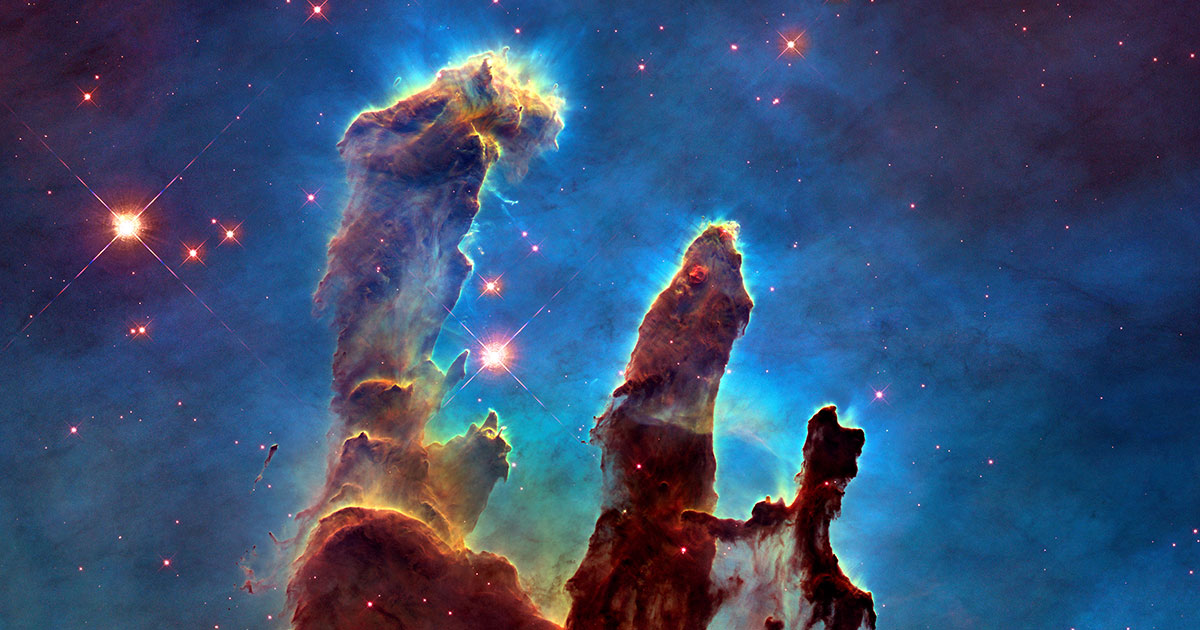
One of Hubble’s most iconic, mystical images is of the stellar nursery, described often as the Pillars of Creation, in the Eagle Nebula, a star-forming region 7,000 light-years away in the constellation Serpens. NASA
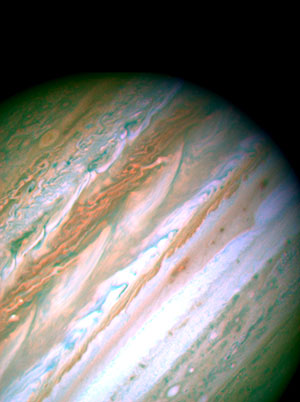
Two continent-sized storms erupt in Jupiter’s atmosphere in this image from Hubble in March 2007, showing that the massive planet’s internal heat plays an important role in generating atmospheric disturbances. NASA/ESA
THE GREATEST THING
“It was not the heaviest of launches,” Webster, who retired in 2000, said in an interview with Space Coast Living. “However, it [Hubble Space Telescope] pretty much filled the payload bay.”
He was in awe of the Hubble, built for the ultraviolet and near-infrared wavelengths. A few days before liftoff, he walked to the launch site to conduct final closeout inspections in the payload changeout room.
“My most vivid memory is standing on that orbiter and the bottom of the telescope was 6 or 8 inches above my head,” Webster says. “That’s something you never forget. To be that close to the telescope is just something else.”
Payload ground crews were experienced in prepping scientific equipment for missions, but the Hubble was unique.
“We were problem-solving, but we didn’t know what the problems would be,” Webster explains, noting that the shared goal of keeping the astronauts safe defined every shuttle mission. “Our job was to get it launched safely and get it back and then turn around and do it again.”
For his dedication, he was awarded the astronaut-nominated Silver Snoopy Award. After the Hubble Space Telescope’s 30th anniversary in 2020, Webster purchased and assembled Lego replicas of Hubble and Discovery to honor the work he describes as “the greatest thing in the world.”
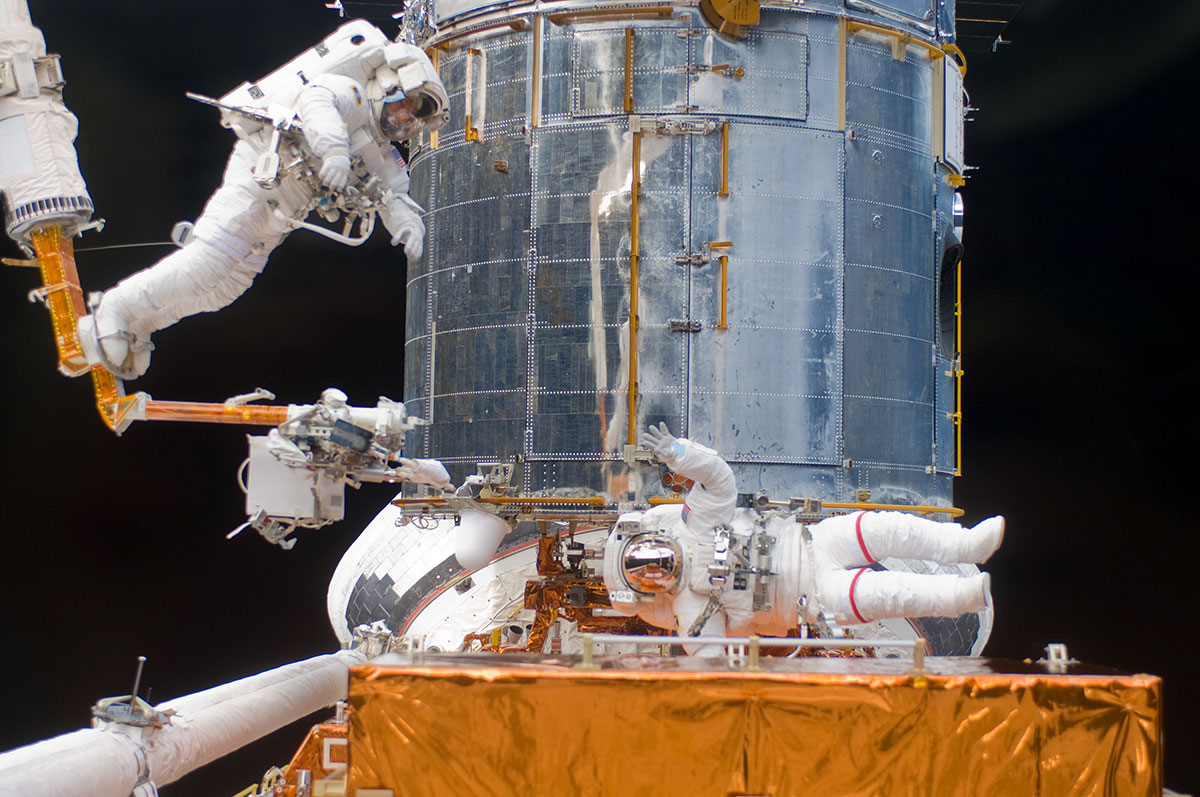
Mission specialist Andrew Feustel navigates near the Hubble on the end of the remote manipulator system arm, controlled by an Atlantis crew member during the final servicing mission for the telescope in 2009. Astronaut John Grunsfeld signals to his crewmate from a few feet away. They are at work on the giant observatory which is locked down in the cargo bay of the shuttle. NASA
A SPACE WALK TO REMEMBER
Decades of planning went into Hubble. NASA and the European Space Agency cooperated in the massive endeavor, which started in 1977 on Congressional approval. Every NASA field center and scientists worldwide worked on it. Marshall Space Flight Center led its design and construction team. Lockheed Missiles and Space, now Lockheed Martin, built the telescope, and Elmer-Perkin Corp., now Hughes Danbury Optical Systems, ground the primary mirror. The Goddard Space Flight Center led the telescope’s design and is in charge of ground control, and the Space Telescope Science Institute in Baltimore oversees telescope time and manages its observations. The Johnson and Kennedy space centers provided shuttle support.
Hubble’s first projected launch was delayed four years while NASA worked to make the shuttle program safer following the Challenger explosion that killed the seven crew members on Jan. 28, 1986.
But after the space telescope launched and began transmitting images, fanfare dimmed quickly: The images from the $1.5 billion instrument were blurry. The edge of the primary mirror had been ground too flat by a fraction of a human hair’s width.
In December 1993, space shuttle Endeavor flew a crew of seven astronauts to Hubble to repair its mirror with a new wide field planetary camera and COSTAR, an instrument the size of a phone booth with five pairs of corrective mirrors in it, and install a new wide-field and planetary camera.
The mission was urgent. Crew member Story Musgrave describes it as the most important one in history. Astronaut and physicist Kathryn Thornton was among the first astronauts to have done space walks, which were needed for Hubble’s repairs. She and teammate Tom Akers installed new solar arrays and installed COSTAR among other tasks. Thornton, a professor of engineering emeritus at the University of Virginia, was inducted into the Astronaut Hall of Fame in 2010 for her work at NASA.
“There weren’t many of us in the office at that time who had done space walks,” Thornton says, recalling the mission’s high stakes in the documentary, Hubble: 30 Years of Discovery, aired by the BBC-Science Channel April 19, 2020. “I just didn’t want to mess up.”
She has vivid memories for many reasons of the crucial mission: It launched on her middle daughter’s birthday. “I got permission to call and wish her a happy birthday,” she says.
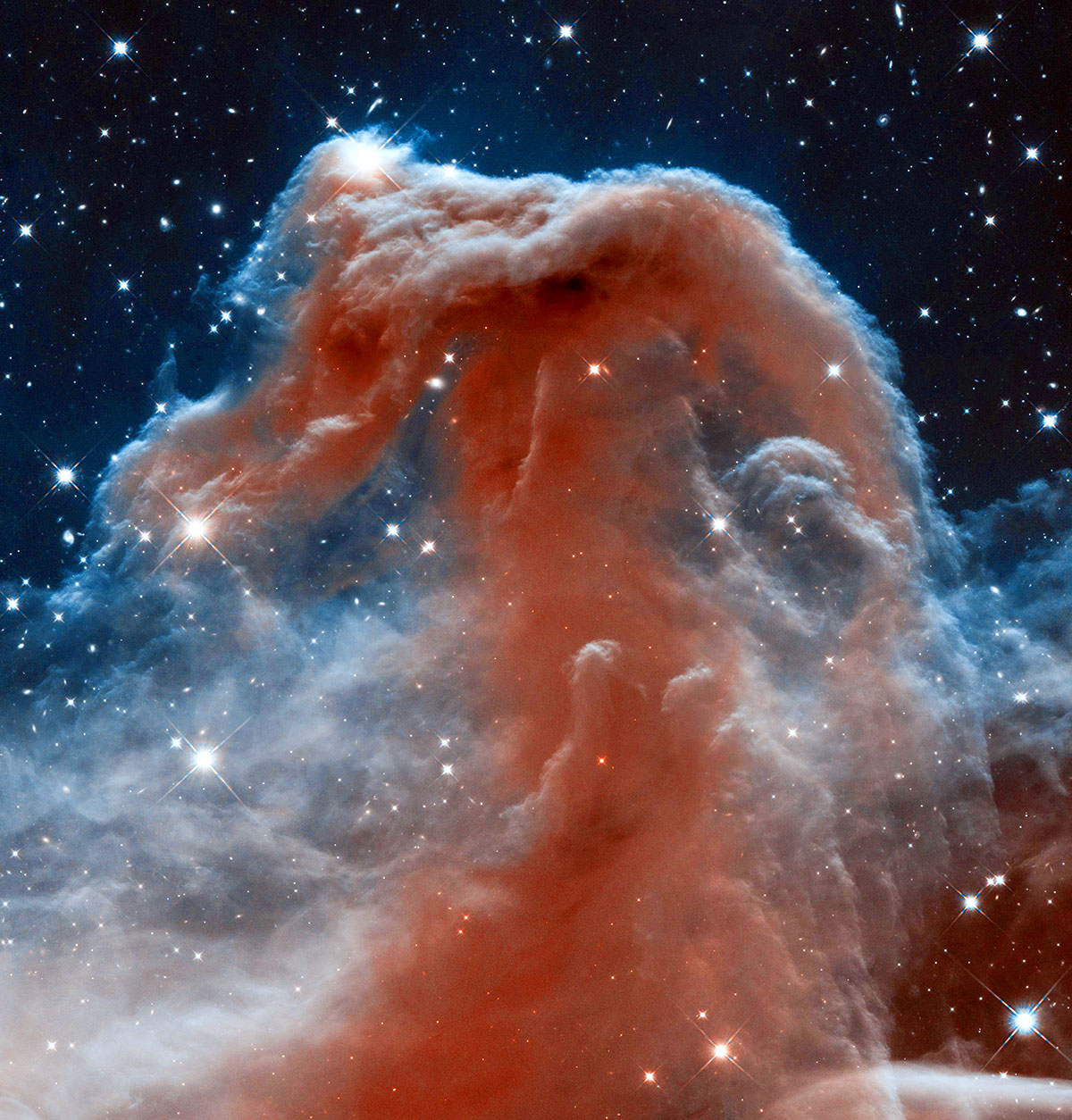
Backlit wisps along the Horsehead Nebula upper ridge are illuminated by Sigma Orionis, a young five-star system off the top of this image transmitted in 2013 by the Hubble Space Telescope. These and other images show the far reaches of space. NASA/ESA/STScI
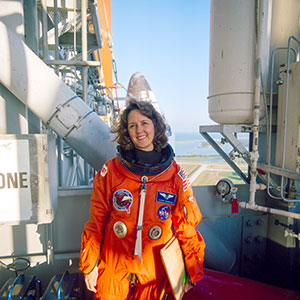
Astronaut and physicist Kathryn Thornton has logged more than 975 hours in space, including 21 hours of space walks. NASA
THE UNIVERSE’S ORIGINS
The first service mission’s immediate success catapulted Hubble into celebrity status.
When comet Levy-Shoemaker 9 crashed into Jupiter seven months later, the new space observatory, along with lesser space telescopes, gathered close detail of the impact over several days. It was the first time astronomers had observed two solar system bodies collide.
From 1993 through 2009, the shuttles transported 32 astronauts during five service trips to Hubble. Sixteen of those astronaut-scientists walked in space to remove old equipment; install new equipment such as wide-field planetary mirrors and new cameras and gyroscopes; and upgrade electronics and other equipment for Hubble’s increasingly long view back to the origins of the universe.
By 1995, Hubble had sent now-iconic images of the stellar nursery where stars form in the swirling gases of the Milky Way Galaxy’s Eagle Nebula, often described as the Pillars of Creation. Since then, the observatory has confirmed the presence of super massive black holes, the acceleration of an expanding universe and has revealed images from 13.5 billion light years ago revealing galaxies and mysteries. As did its 20th century namesake, Edwin Hubble, the space observatory revolutionized the world’s knowledge of the universe. It has contributed also to understanding the Earth’s solar system.
Its biggest test of survival came a year after the second shuttle disaster in January 2003, when Columbia broke apart over Texas on re-entry into the atmosphere, killing all seven crew members. NASA’s initial plan to scrap one last, vital service mission following the disaster was met with hearty resistance from scientists worldwide. Their calls for help spread quickly.
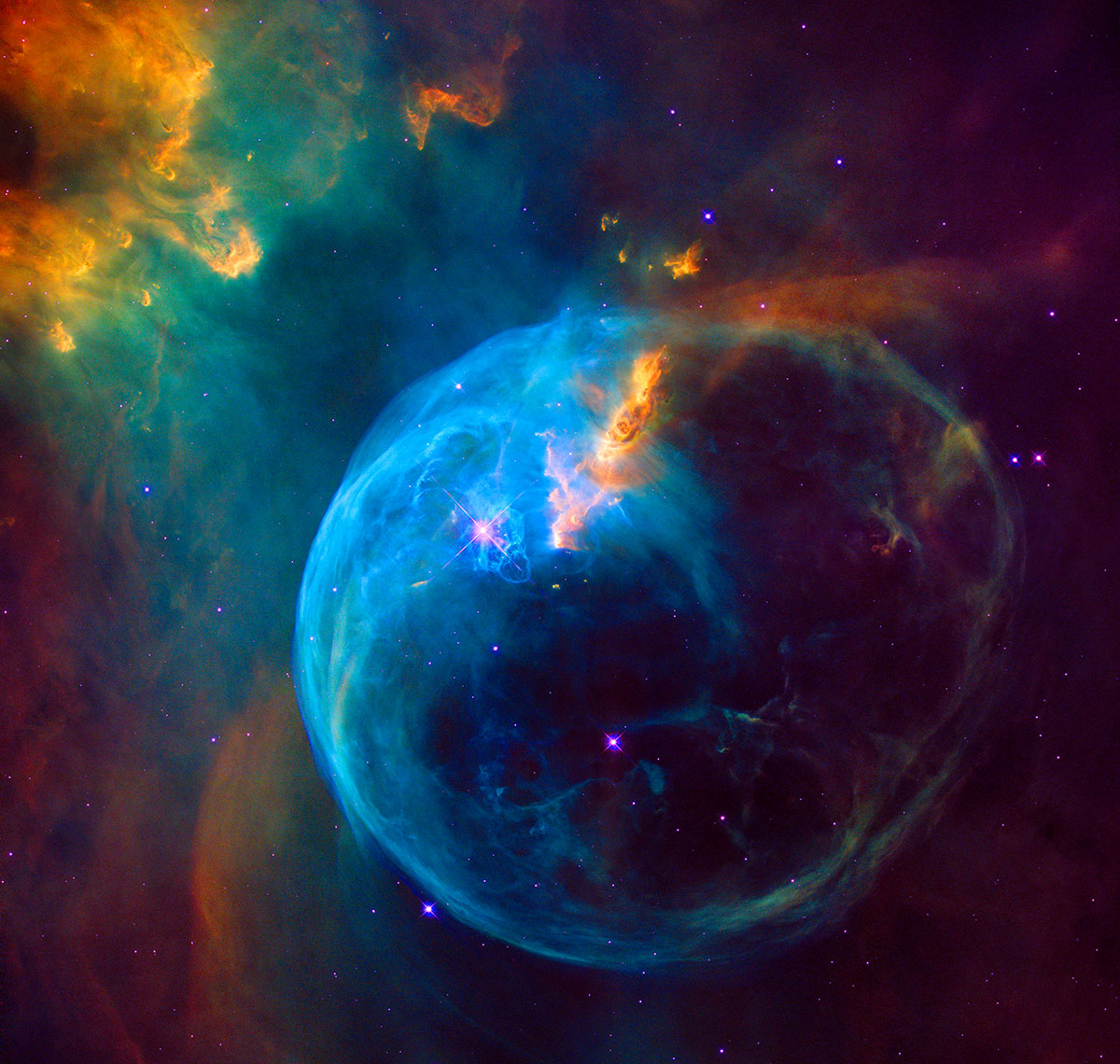
Hubble’s image of the Bubble Nebula, or NGC 7635, marks the 26th anniversary of the observatory’s launch into Earth orbit on April 24, 1990. The nebula is seven light years across and resides 7,100 light-years from Earth in the constellation Cassiopeia. NASA/HUBBLESITE
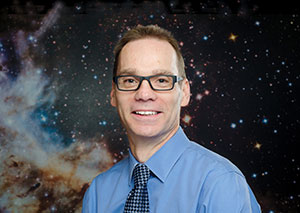
Astronomer Kenneth Sembach is widely known for interpreting Hubble’s science and cultural impact. With Hubble showing people views of the universe they had never seen before, they were able to comprehend the potential for discovery in space. STScl
THE PEOPLE’S TELESCOPE
By 2004, Hubble had earned the moniker, the people’s telescope, as advocacy grew and children were mailing pennies to NASA for needed repairs.
“Hubble showed people a view of the universe they had never seen before,” astronomer Kenneth Sembach, recent director of the Space Telescope Science Institute, says in a telephone interview with Space Coast Living. “It represented the potential for discovery.”
Extensive news coverage of both the observatory’s troubles and its spectacular images helped also.
“It’s almost as if a family member is in the hospital in the operating room, and the public had a front row seat for the corrective measures to be made,” Sembach says.
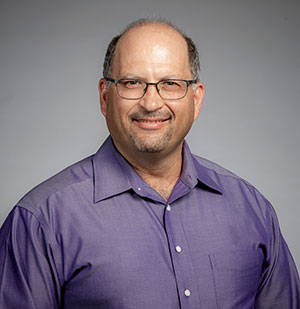
Florida Institute of Technology astrophysics professor Eric Perlman recalls the local excitement of the launch of Hubble’s final service mission in 2009. FLORIDA INSTITUTE OF TECHNOLOGY
“There’s a human bonding that goes with this inanimate instrument. It extends into art, music, storytelling, so it becomes folded into the public conscience.”
Astrophysicist Eric Perlman, professor at Florida Institute of Technology, agrees. His more than 27 years of research on black holes includes extensive work with Hubble data. He also conducts summer institutes with high school science teachers. “Every teacher has a story about when or how they became mesmerized with Hubble, and they have a favorite image,” Perlman says in a Space Coast Living interview. “It most definitely is the people’s telescope.”
In May 2009, the shuttle Atlantis ferried key equipment and the repair crew for Hubble’s last service mission. The five space walks performed for the upgrades gave the observatory greater capability than ever before. It came none too soon, for the shuttle program would end in 2011.
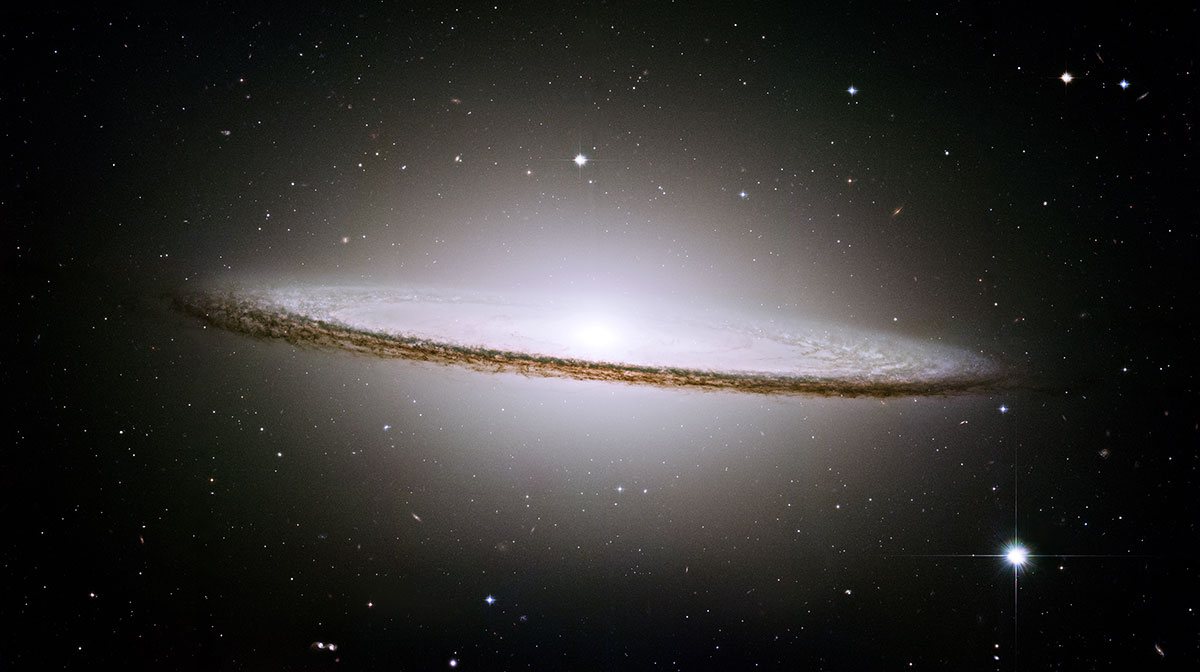
Considered one of the universe’s most photogenic galaxies, the Sombrero galaxy, Messier 104, lies at the southern edge of the Virgo cluster of galaxies and is one of the most massive objects in that group, equivalent to 800 billion suns. The ages of the globular clusters are similar to those in the Milky Way, ranging from 10-13 billion years old. NASA/HUBBLE HERITAGE TEAM
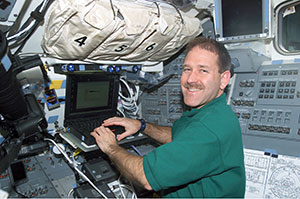
Astronaut John Grunsfeld’s work on and in support of Hubble defines his career at NASA. An astronaut and astrophysicist, he made several trips to Hubble during a 10-year span from 1999-2009. Grunsfeld is a member of the Astronaut Hall of Fame. NASA
WHERE EVERYTHING COMES TOGETHER
Astronaut and astrophysicist John Grunsfeld led two of the three repair trips he made to Hubble from 1999 to 2009. He served as NASA’s chief scientist from 2003-2004 and as NASA’s associate administrator for the science directorate in a four-year stint through 2016. In 2015, he was inducted into the Astronaut Hall of Fame. A noted figure, he long ago braided a child’s dream of space into a scientist’s sophisticated inquiry. He channels Star Trek’s Mr. Spock with the Vulcan greeting to “Live long and prosper” at professional gatherings and refers to himself as a Hubble hugger.
On the last service mission, astronaut Andrew Feustel and Grunsfeld removed the old spectrograph, the size of a phone booth, and replaced it with the new Cosmic Origins Spectrograph. Among other newly installed equipment and repairs made, the repair of the Advanced Camera for Surveys was especially difficult. It and another instrument repair involved removing more than 100 tiny screws on the inside of the telescope. He helped design the tool to do so successfully.
To Grunsfeld, who studies gamma rays on Jupiter’s moon, Europa, Hubble’s impact on space exploration is unparalleled. No astronaut could appreciate more the payload ground crews for the missions that helped save the prolific observatory.
“They should be proud of themselves,” Grunsfeld says of the spaceport’s contributions in a video interview with Space Coast Living.
“Everything comes together there,” he says of the hardware assemblage. “That’s where the Kennedy Space Center really shines, getting everything ready in the payload bay.” The pivotal work is done by what was then known as Level IV payload engineers, described now as experiment integration payload engineers.
“They have to keep our suits safe, they have to test frequently and have to keep everything super clean and safe,” Grunsfeld says, noting that process includes details from the fragile fabric of astronauts’ suits to hardware and equipment. “We were dependent on them at Kennedy for everything to be working, and they had to keep us safe.”
He credits also the space shuttle program for the observatory’s success. “They were incredibly complex vehicles and a remarkable human achievement,” Grunsfeld says, noting that “Discovery is a truly historic bird for launching Hubble.” Discovery flew 39 missions, the most of all the orbiters. It is on permanent display at the National Air and Space Museum’s Steven F. Hudvar-Hazy Center in Chantilly, Virginia.
Astronaut Thornton, too, is in awe of the gargantuan vehicles, which are displayed at various field centers and museums. “As many times as I’ve been to the Kennedy Space Center, it still makes my heart beat faster just to see the hardware,” Thornton says. “You can hear people gasp when they see Atlantis. It’s breathtaking.”
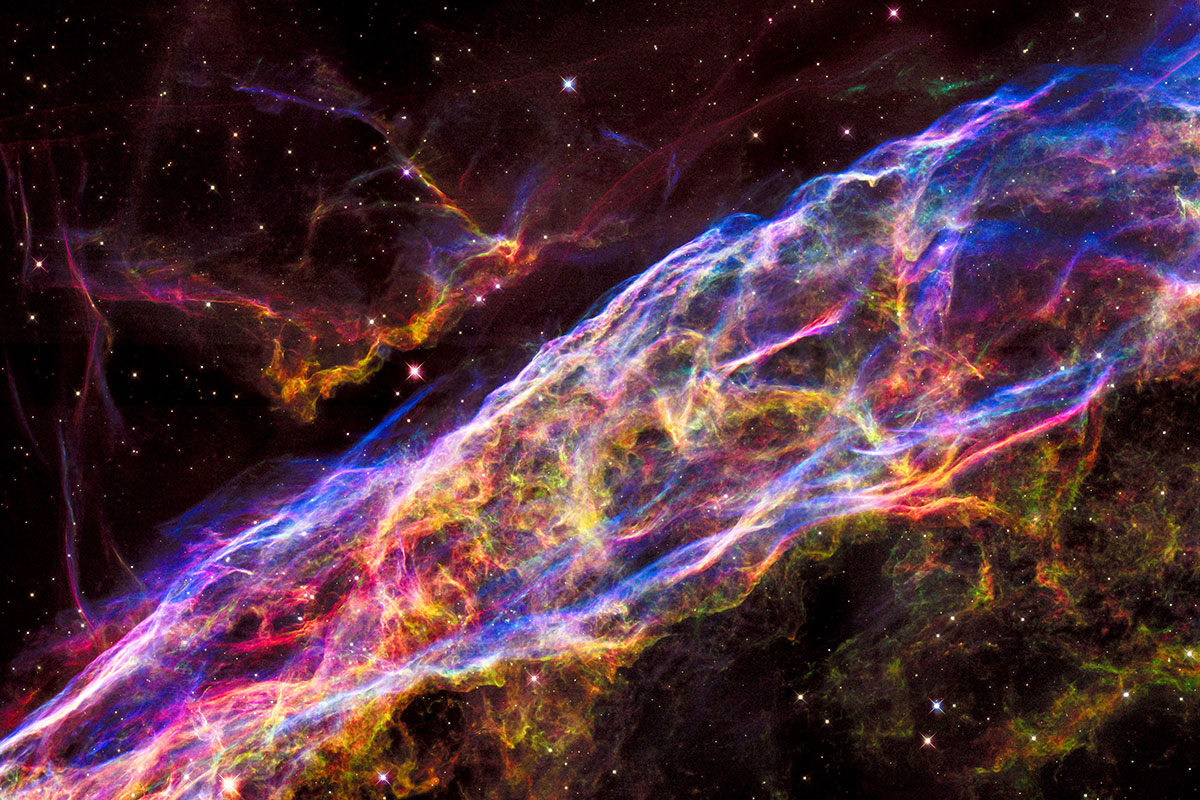
As observed by the Hubble, this section of the Veil Nebula, a supernova remnant, is in a region known colloquially as the Witch’s Broom Nebula. NASA/HUBBLE HERITAGE TEAM
BEAUTY AND KNOWLEDGE
The scientific community agrees that Hubble is a key partner to the new James Webb Space Telescope, which uses the infrared wavelengths. More than 16,000 scientific papers on Hubble have been published. “Generations of scientists will still be looking at Hubble data,” Thornton says.
Its gifts to the world are clear to Grunsfeld. “It helped tell us where we’ve come from, how we got here, where we’re going and it’s opened up a field that someday may tell us whether we’re alone,” he says at the 2015 Astronaut Hall of Fame induction ceremony.
One of his favorite images from Hubble is of gas and dust collapsing in the stellar nursery of the Orion Nebula, in the middle star of Orion’s sword in the storied constellation, Grunsfeld says. “Its biggest contribution to humanity is that it has revealed the immense beauty of the universe.”
